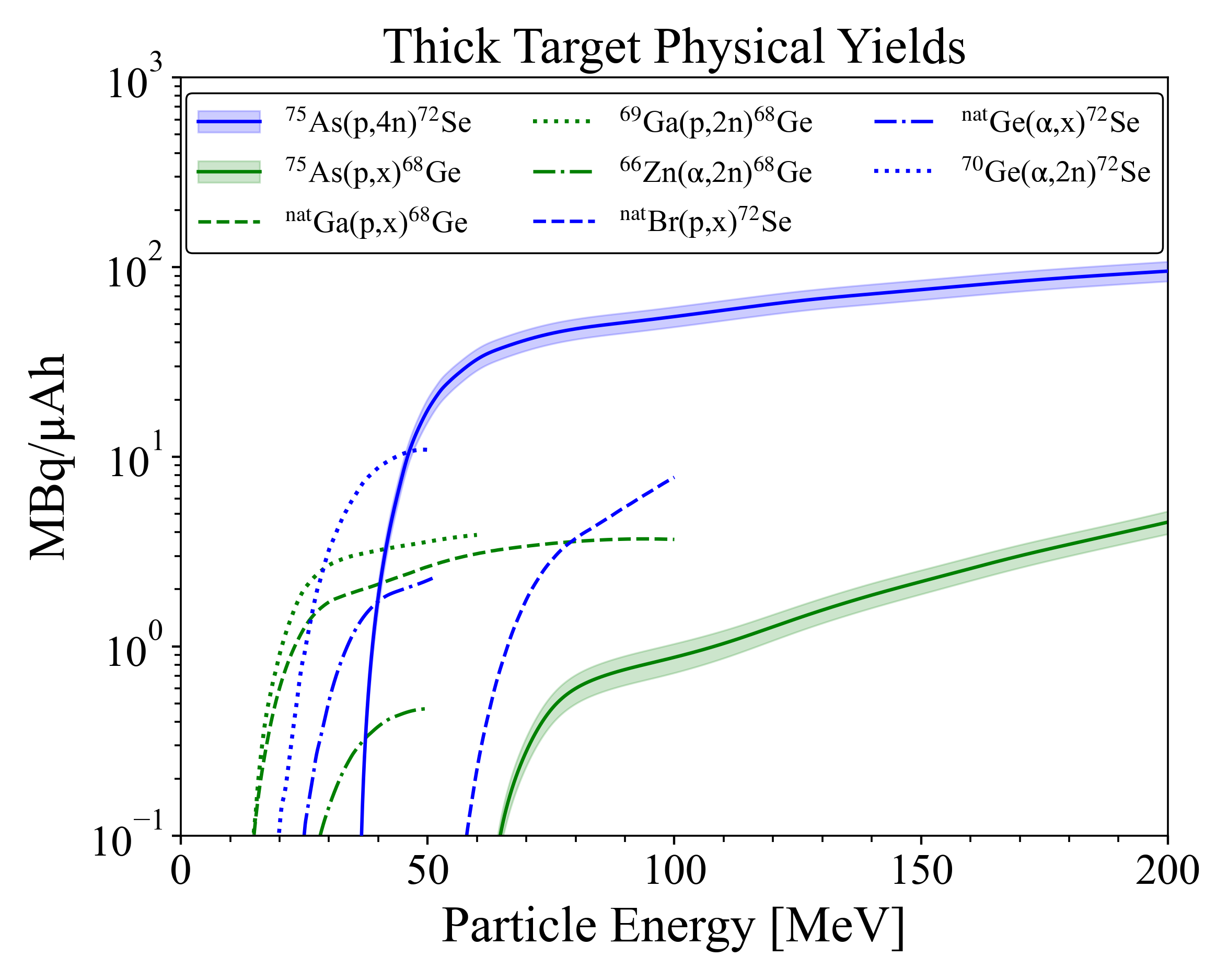Energetic charged particles are one of the workhorses of domestic Isotope Production activities. However, for many isotopes of interest, production cross section data is severely lacking. This project seeks to establish capabilities for charged particle cross section measurements for the nuclear reactions that are relevant to isotope production needs. The focus is on proton reactions induced in the energy range from 0-200 MeV, to leverage the accelerator capabilities of the DoE Isotope Program.
Briefly, a cross section measurement consists of 3 major steps: 1) irradiation of the foil sample; 2) measurement of the induced radioactivity and 3) evaluation of the obtained data. Therefore, establishing cross section measurement capabilities has meant developing both irradiation and improved high-rate counting capabilities at each partner institution. Notably, each year's focus on a particular production pathway offers an ideal opportunity to study the evolution of the nuclear reaction dynamics for a range of reaction products over a broad energy range. This is being used to improve the fidelity of reaction modeling, and each year's focus will form the foundation of the dissertation project for a Ph.D. student involved in the collaboration. This project entered its second year in 2020, and details of specific measurements can be found below:
Measurement of 75As(p,x) Cross Sections Spanning 35-200 MeV by Stacked-Target Activation
The Tri-Laboratory Effort in Nuclear Data (TREND) is comprised of researchers from the Lawrence Berkeley, Los Alamos, and Brookhaven National Laboratories. The three facilities currently central to TREND are the 88-Inch Cyclotron at Berkeley (\(E_{p,max}\) = 60 MeV), the Isotope Production Facility (IPF) in Los Alamos (\(E_{p,max}\) = 100 MeV), and the Brookhaven LINAC Isotope Producer (BLIP) at Brookhaven (\(E_{p,max}\) = 200 MeV). This national lab teaming ties together three prominent nuclear data facilities and provides an innovative capability to perform experiments and extract high-fidelity data across broad energy ranges.

TREND’s first experiments were performed during 2018-2019 to measure proton-induced nuclear reaction data for \(^{75}\)As. These experiments, conducted using the stacked-target experimental technique included specific high-priority nuclear medicine investigations into the production of the \(^{72}\)Se/\(^{72}\)As and \(^{68}\)Ge/\(^{68}\)Ga PET generator systems via \(^{75}\)As(p,x).

Our collaboration reported the first measurements of \(^{75}\)As(p,x)\(^{68}\)Ge as well as the most well-characterized excitation function for \(^{75}\)As(p,4n)\(^{72}\)Se. The \(^{72}\)Se production results in particular, i.e., the proper characterization of an excitation function from threshold to 200 MeV where little prior data existed, are emblematic of the overall TREND endeavor.
In the first year of stacked-target experiments, TREND actually measured high-energy cross sections for a total of 78 products, stemming from the investigation and exploration of proton reactions on niobium, copper, and titanium targets, in addition to arsenic.

Our collaboration uses these results to both better inform accelerator facilities of optimal parameters for medical isotope production and to study reaction modeling of high-energy (p,x) reactions. These insights are important to a multitude of nuclear data applications such as aerospace radiation shielding and particle transport.
The following publications expand on TREND and thoroughly detail the stacked-target experimental methodology and analysis employed to extract proton-induced production cross sections:
M. B. Fox, A. S. Voyles, J. T. Morrell, L. A. Bernstein, A. M. Lewis, A. J. Koning, J. C. Batchelder, E. R. Birnbaum, C. S. Cutler, D. G. Medvedev, F. M. Nortier, E. M. O'Brien, and C. Vermeulen, “Investigating high-energy proton-induced reactions on spherical nuclei: Implications for the preequilibrium exciton model,” Phys. Rev. C, 103 (3), 034601 (2021), doi:10.1103/PhysRevC.103.034601.
M. B. Fox, A. S. Voyles, J. T. Morrell, L. A. Bernstein, J. C. Batchelder, E. R. Birnbaum, C. S. Cutler, A. J. Koning, A. M. Lewis, D. G. Medvedev, F. M. Nortier, E. M. O’Brien, and C. Vermeulen, “Measurement and Modeling of Proton-Induced Reactions on Arsenic from 35 to 200 MeV,” arXiv: nucl-ex, 2021. https://arxiv.org/abs/2106.04115.
Our collaboration work continues with antimony and thallium targets, with many more results to come!
Arsenic Target Fabrication and Characterization
Although target fabrication is a fundamental constraint for many nuclear data experiments, the knowledge base and capabilities for target production and characterization that used to exist throughout the U.S. nuclear physics and chemistry communities have steadily disappeared over the past three decades. The gradual loss of expert personnel, facility closures, and a general failure to maintain passed-down knowledge have contributed to the unfortunate deficiency in this highly-important field. In fact, as experimental data measurement equipment and techniques continue to advance, a lack of information about target fabrication has become a leading source of uncertainty in new measurement campaigns.
The TREND measurements of proton-induced reactions on arsenic suffered from these depleted targetry capabilities since minimal established thin-target fabrication routes or guiding research existed to produce arsenic foils suitable for stacked-target experiments. Consequently, no dedicated facilities were available to provide external fabrication support. As a result, all arsenic target fabrication had to be performed by personnel in the TREND collaboration.
We utilized vapor deposition, electrodepositon, scanning electron microscopy, and microanalysis to meet the thickness and uniformity requirements of high-fidelity stacked-target cross section measurement campaigns. Our program also partnered with the UC Davis McClellan Nuclear Research Center and introduced a new thin-target characterization methodology, developed using conventional neutron activation tools, that is reliable, convenient, and non-destructive.

This target fabrication effort is a new development for our research program. We hope to continue these advances and look forward to the extended research scope that these capabilities might bring.
A. S. Voyles, M. B. Fox, J. T. Morrell, M. P. Zach, E. K. Still, L. A. Bernstein, W. D. Frey, and B. J. Mehciz, “Preparation and Characterization of Thin Arsenic Targets for Stacked-Target Experiments,” arXiv: physics.ins-det, nucl-ex, 2021. https://arxiv.org/abs/2106.05524.